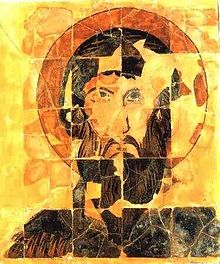Theodor Tiro


Theodor Tiro († February 17, 306 ; also: Theodoros Teron , from ancient Greek Τἠρων Tērōn , Latin tiro "recruit", or Theodoros von Euchaïta , the " recruit from Euchaïta at Amaseia ") is a saint of the Orthodox and Roman Catholic Church .
The oldest surviving mentions of Theodor come from a panegyric homily by Bishop Gregory of Nyssa and a poem of praise by Chrysippus of Jerusalem († 479).
Legend
Theodore, according to legend, the brother of St. George , was a simple soldier in the army of Emperor Maximian in Pontus on the Black Sea and a staunch Christian. He was commander of a garrison in Galatia and suffered in the last Roman persecution of Christians under Maximinus II in Amasia , the capital of the former Roman province Helenopontus , the martyrdom : At the outbreak of the persecution of Christians, he was 306 "interrogated cruelly mangled and burned alive." You had u. a. accused of having set fire to the Roman temple of the Magna Mater .
Theodor was regarded as a specialist in tracking down runaway Christian slaves . It was said that whoever misses a slave and sleeps on his grave, he appears in a dream and show him where the runaway is.
Mixing up the legends
Two people were mixed up in the saints' legends. The simple soldier Theodor Tiro († around 300), also called Theodoros von Euchaïta , mutated into a brother of the legendary George the Dragon Slayer, also fought a dragon and finally took the form of the Roman garrison leader Theodor Stratelates († 319), his Worship has been observed since the 9th century. The Catholic Church worships both in one person. The church lexicon also writes: "In the Eastern Church as in icon art, he is also very often given the name" Theodoros Stratelates "(Theodor, the military leader)." The files of Theodoros Stratelates are considered in research today as re-training and further education Legends about Theodor Tiro, the identity of both characters cannot be doubted; Theodorus von Euchaïta and Theodor Tiro enjoy legal priority and cult status.
Adoration
A pilgrimage church existed over the grave of Theodor in Euchaïta around 400. Theodor was initially the patron saint of Venice before he was replaced by Markus . He is pictured with a crocodile . Today he is the patron saint of Brindisi . In Rome the church of San Teodoro al Palatino is dedicated to him. Churches consecrated to St. Theodore were in Ravenna , Amasya , Şanlıurfa , Nusaybin , Neirab near Damascus and Jerusalem. In Constantinople there were relics and 15 churches of his name. Other relics are also venerated in Venice, Rome, Brindisi and Gaëta as well as in Wemding . He is the patron saint of soldiers, in battles and in storms. In the parish church of St. Sebastian in Mannheim there is a reliquary altar of St. Theodor , donated by Elector Karl Theodor in 1778 , in honor of his namesake. In Germany, three churches bear the Theodor patronage : the monastery churches of the Carmelite monastery in Bamberg and the Benedictine abbey of Ottobeuren as well as the parish church of St. Theodor in Cologne- Vingst .
An imposing icon of the saint from the 9th century made of painted white ceramic, found in the Bulgarian city of Veliky Preslav .
Name days
- Name day : Western Church November 9th ; Eastern Church February 17th
literature
- Otto Volk : Theodoros v. Euchaïta . In: Walter Kasper (Ed.): Lexicon for Theology and Church . 3. Edition. tape 9 . Herder, Freiburg im Breisgau 2000, Sp. 1411 .
- Ekkart Sauser : Tyron (also Theodorus gen.). In: Biographisch-Bibliographisches Kirchenlexikon (BBKL). Volume 12, Bautz, Herzberg 1997, ISBN 3-88309-068-9 , Sp. 780-781.
- Klaus-Peter Todt : Theodor of Euchaita. In: Biographisch-Bibliographisches Kirchenlexikon (BBKL). Volume 11, Bautz, Herzberg 1996, ISBN 3-88309-064-6 , Sp. 875-881.
- Theodor Stratelates . In: Complete Lexicon of Saints, Volume 5. Augsburg 1882, p. 462.
- Theodor Tiro . In: Complete Saint Lexicon, Volume 5. Augsburg 1882, pp. 469-470.
- Benjamin Fourlas: An early Byzantine silver bowl with the depiction of Saint Theodor , yearbook of the Roman-Germanic Central Museum Mainz 55, 2008, 483-528 [primarily on the early iconography of the saint].
Web links
- Saint Theodor von Euchaita in: Diocese of Münster kirchensite.de
Individual evidence
- ↑ Otto Volk: Theodoros v. Euchaïta . In: Walter Kasper (Ed.): Lexicon for Theology and Church . 3. Edition. tape 9 . Herder, Freiburg im Breisgau 2000, Sp. 1411 .
- ↑ Catherine Nixey: The Darkening Age. The Christian Destruction of the Classical World. Macmillan, London 2017, p. 204.
- ↑ Ecumenical Lexicon of Saints,
- ↑ Ekkart Sauser : Tyron (also Theodorus gen.). In: Biographisch-Bibliographisches Kirchenlexikon (BBKL). Volume 12, Bautz, Herzberg 1997, ISBN 3-88309-068-9 , Sp. 780-781.
- ↑ Otto Volk: Theodoros v. Euchaïta . In: Walter Kasper (Ed.): Lexicon for Theology and Church . 3. Edition. tape 9 . Herder, Freiburg im Breisgau 2000, Sp. 1411 .
| personal data | |
|---|---|
| SURNAME | Theodor Tiro |
| ALTERNATIVE NAMES | Theodore of Amasea |
| BRIEF DESCRIPTION | Holy soldier |
| DATE OF BIRTH | 3rd century |
| DATE OF DEATH | February 17, 306 |
| Place of death | Amasya , Turkey |

